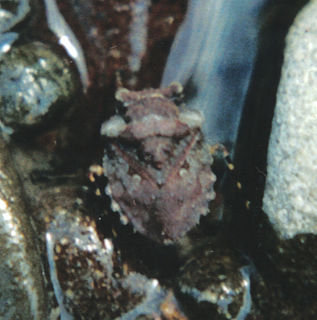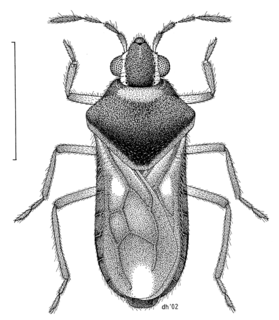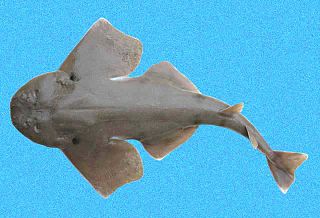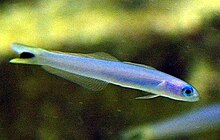
Hemiptera or true bugs are an order of insects comprising over 80,000 species within groups such as the cicadas, aphids, planthoppers, leafhoppers, bed bugs and shield bugs. They range in size from 1 mm (0.04 in) to around 15 cm (6 in), and share a common arrangement of sucking mouthparts. The name "true bugs" is often limited to the suborder Heteroptera. Many insects commonly known as "bugs", especially in American English, belong to other orders; for example, the lovebug is a fly and the May bug and ladybug are beetles.

The Heteroptera are a group of about 40,000 species of insects in the order Hemiptera. They are sometimes called "true bugs", though that name more commonly refers to the Hemiptera as a whole. "Typical bugs" might be used as a more unequivocal alternative, since the heteropterans are most consistently and universally termed "bugs" among the Hemiptera. "Heteroptera" is Greek for "different wings": most species have forewings with both membranous and hardened portions ; members of the primitive sub-group Enicocephalomorpha have completely membranous wings.

The Pentatomoidea are a superfamily of insects in the Heteroptera suborder of the Hemiptera order. As Hemiptera, they share a common arrangement of sucking mouthparts. The roughly 7000 species under Pentatomoidea are divided into 21 families. Among these are the shield bugs, giant shield bugs, burrower bugs, and stink bugs.

Pyrrhocoridae is a family of insects with more than 300 species world-wide. Many are red coloured and are known as red bugs and some species are called cotton stainers because their feeding activities leave an indelible yellow-brownish stain on cotton crops. A common species in parts of Europe is the firebug, and its genus name Pyrrhocoris and the family name are derived from the Greek roots for fire "pyrrho-" and bug "coris". Members of this family are often confused with, but can be quickly separated from, Lygaeidae by the lack of ocelli on the top of the head.

Coreidae is a large family of predominantly sap-suckling insects in the Hemipteran suborder Heteroptera. The name "Coreidae" derives from the genus Coreus, which derives from the Ancient Greek κόρις (kóris) meaning bedbug.

The Gelastocoridae is a family of about 100 species of insects in the suborder Heteroptera. These fall into two genera, about 15 species of Gelastocoris from the New World and 85 of Nerthra from the Old World. They are reminiscent of toads both in the warty appearance and hopping movements of some species.

Veliidae is a family of gregarious predatory insects in the suborder Heteroptera. They are commonly known as riffle bugs, small water striders, or broad-shouldered water striders because the segment immediately behind the head is wider than the rest of the abdomen. The genus Rhagovelia is also referred to as a ripple bug.

The Miridae are a large and diverse insect family at one time known by the taxonomic synonym Capsidae. Species in the family may be referred to as capsid bugs or "mirid bugs". Common names include plant bugs, leaf bugs, and grass bugs. It is the largest family of true bugs belonging to the suborder Heteroptera; it includes over 10,000 known species, and new ones are being described constantly. Most widely known mirids are species that are notorious agricultural pests that pierce plant tissues, feed on the sap, and sometimes transmit viral plant diseases. Some species however, are predatory.

Nepidae is a family of exclusively aquatic Heteropteran insects in the order Hemiptera. They are commonly called water scorpions for their superficial resemblance to scorpions, due to their raptorial forelegs and the presence of a long slender process at the posterior end of the abdomen, resembling a tail. There are 14 genera in the family, in two subfamilies, Nepinae and Ranatrinae. Members of the genus Ranatra, the most widespread and species-rich genus, are sometimes called needle bugs or water stick insects as they are slenderer than Nepa.

Enicocephaloidea is a sole superfamily within the infraorder Enicocephalomorpha of the hemipteran suborder Heteroptera. The group was formerly thought to be related to the Reduviidae because of similarities in head structure but they are now considered different enough from other Heteroptera to constitute a separate infraorder and represents a sister group of the Leptopodomorpha. They are predaceous and some species are known to swarm but little is known of their life history. A few species of enicocephalids are known to shed their wings before entering the surface of subsoil.

Nepomorpha is an infraorder of insects in the "true bug" order (Hemiptera). They belong to the "typical" bugs of the suborder Heteroptera. Due to their aquatic habits, these animals are known as true water bugs. They occur all over the world outside the polar regions, with about 2,000 species altogether. The Nepomorpha can be distinguished from related Heteroptera by their missing or vestigial ocelli. Also, as referred to by the obsolete name Cryptocerata, their antennae are reduced, with weak muscles, and usually carried tucked against the head.

Rhopalidae, or scentless plant bugs, are a family of true bugs. In older literature, the family is sometimes called "Corizidae". They differ from the related coreids in lacking well-developed scent glands. They are usually light-colored and smaller than the coreids. Some are very similar to the orsilline lygaeids, but can be distinguished by the numerous veins in the membrane of the hemelytra. They live principally on weeds, but a few are arboreal. All are plant feeders. The type genus for the family is: Rhopalus. Currently 30 genera and over 240 species of rhopalids are known. The oldest fossil rhopalids described are from the Middle Jurassic of Inner Mongolia, discovered from the Haifanggou Formation. They are not considered economically important with a few species being pests of ornamental trees.

The Tingidae are a family of very small insects in the order Hemiptera that are commonly referred to as lace bugs. This group is distributed worldwide with about 2,000 described species.

Ptereleotris hanae, the blue gudgeon dartfish, blue hana goby, is a species of dartfish native to the western Pacific Ocean. It is a reef inhabitant, being found at depths of from 3 to 50 metres, though usually no shallower than 6 metres (20 ft). It inhabits burrows made by alpheid shrimp, but unlike the Amblyeleotris gobies who normally associate with these shrimp, this species has no interactions with their shrimp hosts. This species can reach a length of 12 centimetres (4.7 in) TL. It can also be found in the aquarium trade.

Urostylididae is a family of true bugs and is considered a basal or "primitive" family within the stink-bug lineage. They are found only in Asia. Older works used the spelling Urostylidae but this clashes with the name used for a protozoan family and a spelling correction (emendation) has been suggested that also avoids the confusion created by homonyms. The family name Urolabididae has also been used for some members in the past.

Schizopteridae is the largest family in the infraorder Dipsocoromorpha and comprises 56 genera and approximately 255 species. Schizopterids are some of the smallest (0.5–2.0 mm) true bugs. Members of this family can be distinguished by their small size, enlarged forecoxae and varying degree of abdominal and genitalic asymmetry in males. Schizopteridae exhibit a wide range of simple and complex wing venation patterns–some species even possess true elytra. The group is currently divided into three subfamilies: Schizopterinae, Ogeriinae and Hypselosomatinae.

Ptereleotris is a genus of dartfishes found in the Atlantic, Indian and Pacific oceans.

The disparate angelshark is a species of angelshark. It occurs at depths down to 164 m in the Gulf of Mexico and reaches a length of 49 cm (19 in). Heteroptera in its name refers to the difference in size, shape and area of the two dorsal fins. Disparate angelsharks have the typical angel shark body form that is broadly flattened with large pectoral/pelvic fins and eyes and spiracles on the top of their heads. Their common and species name comes from them having dorsal fins of very different sizes, shapes, and areas compared to other angel sharks.

Helotrephidae is a family of aquatic bugs found mainly in the tropical regions with many species in the Oriental Realm and a few from Africa, Madagascar and South America. These bugs are found swimming or walking amid submerged vegetation in stagnant or slow moving, shaded freshwater in forest habitats. They are a sister group of the Pleidae.

Hermatobates is a genus of wingless marine bugs placed as the sole genus in the family Hermatobatidae that are sometimes known as coral-treaders. They are quite rare and known only from coral reefs in the Indo-Pacific region. During low tide, they move over the water surface not unlike the more familiar water-striders around coral atolls and reefs and stay submerged in reef crevices during high tide.



















